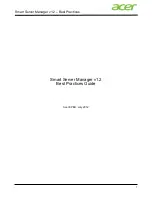
13
Chapter 3: Basics
3.1 Editing philosophy
Your system operates in a non-linear fashion.
This means that every recorded scene can be
accessed instantly. The system does not have
to spool tape to access the desired scene. Direct
access is achieved by recording the video onto
a hard drive and not onto tape. On tape, scenes
can only be accessed by time-consuming spoo-
ling.
A hard drive is actually a storage device from
the field of computers and it is used for storing
programs (software) and data (video and audio).
Hard drives store data differently than tape,
because hard drives have a freely movable read/
write head, which can move directly to any area
of the drive similar to a record player needle, but
in a very short period of time (approx. 10 millise-
conds).
This means that there is practically no waiting
times, even when jumping from the beginning
to the end of a video. This technique is called
"random access" (you are probably familiar with
the well-known abbreviation RAM – Random
Access Memory).
Random access (or direct access) is the fun-
damental characteristic of a non-linear editing
system. It makes possible direct and total control
over the recorded data.
Editing is therefore somewhat different than
with traditional analog devices. The following
principles apply to SMART EDIT video editing:
1. Recording
of the desired material (video
and audio), either completely or in designated
sequences, which is stored in up to ten indepen-
dent projects.
2. Splitting
of the recorded material into indi-
vidual scenes that can each be named as you
choose.
3. Trimming
of the individual scenes (setting the
In/Out points to ignore unwanted footage).
4. Sequential ordering
of the trimmed scenes on
the storyboard, in the order that you designate.
You can also add
Insert Scenes
, (the overlapping
of video without affecting the original audio).
5.
Selection and use of
Transition effects
(e.g.
crossfade, double exposure, etc.), many in real-
time (no rendering is required)
6.
Selection of
Image Processing
effects (e.g.
solarize, sharpen, etc.) to add to scenes or entire
sequences.
7.
Titling
of the storyboard (the addition of text
in different fonts, sizes, colors, and effects).
8. Audio mixing
with up to six tracks for origi-
nal sound, commentary, background music and
sound effects
9. Recording
of the finished project out to video
tape or - if your system is provided with a DVD
writer and with the software "
DVD-Arabesk
" - to
DVD
And of course, you can record and edit more
footage at any time. There is no set sequence.
This list serves only to outline the basic concepts
involved.
3.2 The user interface
Your system makes use of the
SMART EDIT
user-interface, which contains various elements.
These elements are explained here, although
they are fairly obvious.
Light gray buttons can be selected (clicked). Dark
gray buttons cannot be activated. Using certain
functions may cause some buttons to de-activa-
te, meaning they cannot be used.
Some buttons may appear usable but at the mo-
ment have no corresponding function. If they are
clicked, a red, crossed-out circle appears indica-
ting that no function is currently possible.
Buttons
Such buttons are simple gray fields containing
a text caption that describes the function they
perform. They cause something to happen when
they are clicked on, and they are usually clearly
labeled. (e.g. Clicking with the left trackball but-
Summary of Contents for SMART EDIT 5
Page 1: ...User manual SMART EDIT 5 2nd edition ...
Page 100: ...274 06 06 ...














































